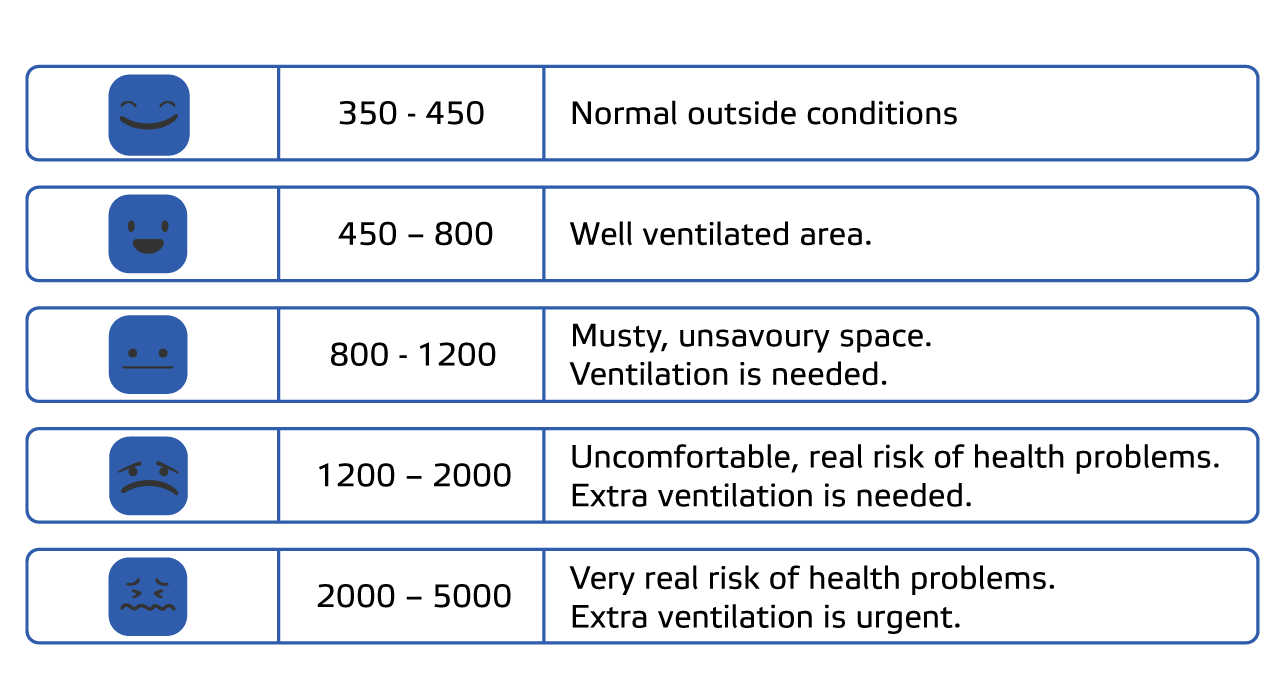What is Carbon Dioxide
What is Carbon Dioxide
Carbon Dioxide or CO2 is a greenhouse gas that is natural and harmless in small quantities. It is necessary for the survival of life on earth. CO2 is not only the result from burning fossil fuels. Indoor carbon dioxide concentrations are the result of a combination of outdoor CO2, indoor breathing and the ventilation rate of the building. As buildings and homes become more energy-efficient and thus airtight, this means we have less fresh air coming naturally into the building. Many of today’s ventilation systems recycle air to conserve energy, thus pushing contaminated air back into the building rather than cycling in new fresh air. This results in high CO2 concentrations and poor indoor air quality. Air flow should be monitored to ensure fresh air is supplied in due time.
The effects of CO2
The effects of CO2
Moderate to high levels of carbon dioxide can cause headaches, reduced concentration and fatigue while higher concentrations can even produce nausea, dizziness and vomiting. Loss of consciousness can occur at extremely high concentrations. To prevent or reduce high concentrations of carbon dioxide in a building or room, fresh air should be supplied to the room.
Indoor CO2 levels constantly change, depending on the ventilation, the amount of people and the length of time they are present in an enclosed space. Indoor CO2 levels between 400-1.000 ppm are acceptable. When the values exceed this range, additional measures should be taken. This can be done by regularly replacing the air filters in indoor fan systems and installing a CO2 sensor to remind you when fresh air needs to enter the space.

CO2 sensor

NDIR CO2 sensor
CO2 sensors are available in different price categories, sizes, types, etc. But how do you select the right CO2 sensor for your situation? Check whether it is of high quality and suitable for measuring in the space you want to install it. Also pay attention to the measurement error or drift, the range, calibration method, LED indicators and data logging possibility.
Sensors that detect CO2 based on the NDIR-principle are held in high regard. The advantage of NDIR – or non-dispersive infrared sensors is their lengthy lifespan, minimal interference of other gases, their low life-cycle cost and precise and stable long-term operation.
The Sentera duct and outdoor CO2 sensors are based on this principle. All our sensors use the ABC self-calibration algorithm. The theory behind ABC self-calibration is that for IAQ use, at some point each day a room is unoccupied and the CO2 level will drop to outside ambient conditions of 400 ppm. With this principle you don’t have to recalibrate the sensor after installation or in the course of time.
Photoacoustic CO2 sensor
Photoacoustic CO2 sensor
Photoacoustic sensors detect the amount of energy that is absorbed by CO2 molecules. When pulsing the infrared emitter, CO2 molecules absorb infrared light periodically. This causes additional molecular vibration resulting in a pressure wave inside the measurement chamber.
The higher the CO2 concentration, the more light is absorbed, and thus the greater the amplitude of this acoustic wave appears near the emitter and lower amplitude appears at the opposite edge of the photoacoustic cell. A microphone inside the gas chamber measures the amplitude of the acoustic wave, from which the CO2 concentration can then be calculated.
The advantages of this sensor compared to sensors with NDIR technology are a greater miniaturisation and freedom to position the emitter and microphone without constraints. Single beam configuration does not allow compensation of IR emitter degradation and is very sensitive to mechanical interferences. In such cases it is advisable to use sensors with NDIR technology.
The Sentera CO2 room sensors all use this type of sensing technology.
